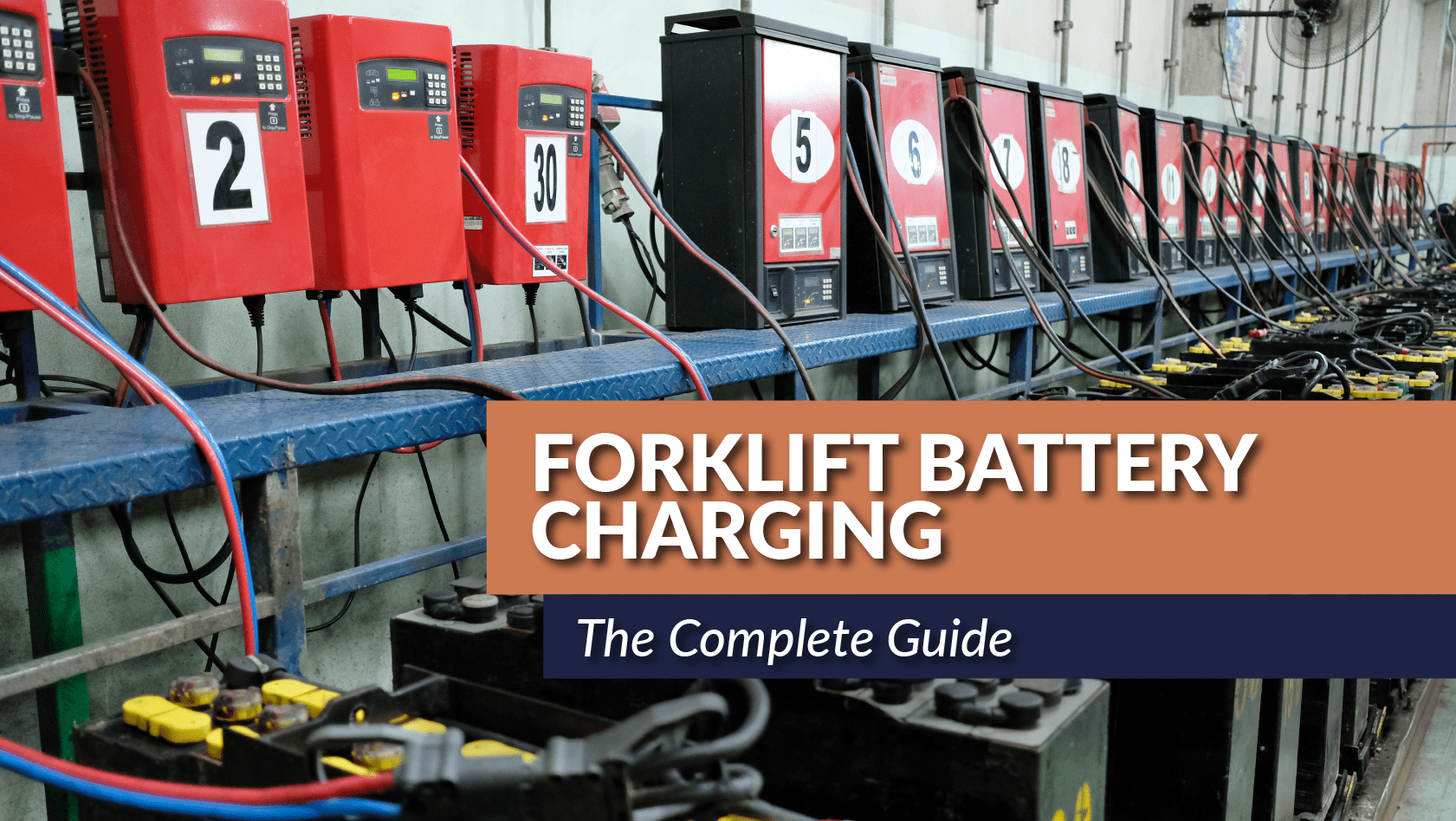
This is your ultimate guide to forklift battery charging.
In this article, you’ll learn:
- When to charge your forklift battery
- The different ways to charge a forklift battery
- Proper forklift battery charging safety techniques
- How to charge a forklift battery step-by-step
- And lots more!
Let’s dive in!
Answer: Charge your forklift battery when it reaches 20% to 30% discharge.
This is considered the “red zone.”
Waiting after this point can cause damage to the battery, which we’ll cover below.
Why Is it Bad to Wait Beyond 20% Discharge?
If the battery drops below 20% discharge, it may experience negative performance issues such as:
- Sulfation build-up
- Battery overheating
- Stratification
These effects can combine to cause damage to your forklift, increase battery maintenance costs, and shorten the battery’s lifespan.
Of these three issues, sulfation is the most noticed effect.
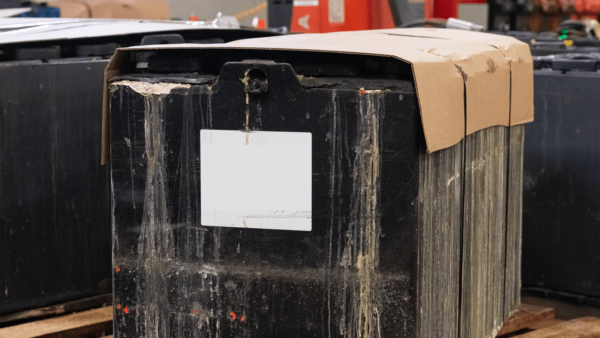
Sulfation is when, during discharge, the sulfuric acid in the electrolyte attaches to the battery plates.
Sulfation may occur when the battery:
- Hasn’t been fully charged in a while
- Water is too low and the electrolyte is too concentrated
- Remains in a depleted state (discharged) for too long
Built-up sulfation, if ignored, hardens and reduces the surface area over which the battery’s chemical reaction can occur.
When this happens, the battery’s performance will be impaired.
So, how can you prevent sulfation?
By properly charging your forklift batteries.
That’s because charging reverses the sulfation process by driving the sulfate from the plates back into the electrolyte acid.
Don’t Take the Battery Off Charge Before it Reaches 100%!
Remember never to interrupt battery charging.
The reason is that batteries only have a limited number of charges.
For example, lead-acid forklift batteries have about 1,500 cycles.
And they can’t differentiate between full or half-charging.
So, each charge uses up a charge cycle, whether it’s an hour of charge or a full charge.
And when you use up a charging unit from the battery’s “bank”, you cannot get that back.
Thus, with each interrupted charge, you shorten your battery’s lifespan.
You need to choose a battery charging method that is right for your battery and forklift.
The three types of charging methods for forklift batteries are:
- Conventional charging
- Opportunity charging
- Fast charging
Let’s discuss each in detail.
Conventional Charging
Conventional charging refers to charging the battery after a shift, using a low current for about 8 to 10 hours until it’s charged 100%.
The charging is then followed by 6 to 8 hours of cooling before using the battery again.
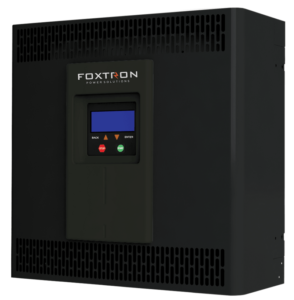
This is why conventional charging is usually done overnight.
Overall, conventional charging is best for single-shift operations.
If you run more than a single shift, you’ll need to have multiple batteries available for each lift truck.
Pros of Conventional Charging
Best for the battery’s health
Best option for getting the most longevity from your battery
Cons of Conventional Charging
Takes longer to charge the battery
Requires extended time to allow the battery to cool down
Not ideal for multi-shift operations
If you have multi-shift operations, you may need to swap batteries, which is dangerous for your employees
Opportunity Charging
Opportunity charging involves using a specialized charger, with a high current, to charge the battery quickly.
Charging can be done on a need basis or when it’s most convenient.
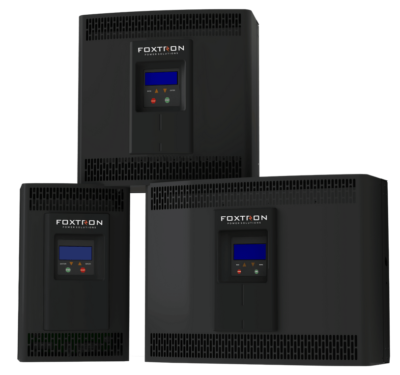
For instance, you can carry out opportunity charging during breaks or an opportune forklift downtime moment.
Overall, opportunity charging works best for multi-shift operations and takes advantage of forklift breaks and shifts.
It’s also ideal if extended use is required.
Pros of Opportunity Charging
Charge fast to reduce downtime and improve productivity
No need to swap batteries
No need for costly battery storage areas
Cons of Opportunity Charging
Uses up more life cycles, reducing battery lifespan
Requires weekly equalizing to reduce sulfation
Fast Charging
Fast charging partially charges your forklift’s battery during opportune moments, usually during breaks or between shifts, but at a quicker rate such as 20 to 30 minutes.
It’s similar to opportunity charging but with a difference in the start rate of the chargers.
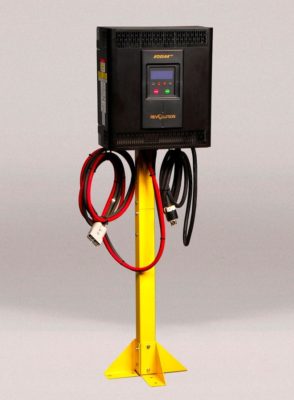
Opportunity charging involves currents of about 20 to 30 amps per 100 amp hours.
Fast charging, on the other hand, uses currents of about 30 to 60 amps per 100 amp hours.
Overall, fast charging works best for multi-shift and continuous use operations.
Pros of Fast Charging
Charge fast to reduce downtime and improve productivity
No need to swap batteries
No need for costly battery storage areas
Cons of Fast Charging
Requires frequent (weekly) battery equalizing to mitigate sulfation
Multi-shift operation contributes to the battery’s shorter lifespan
It causes a lot of heat, which reduces battery life (3 years vs. 5 years for conventional charging)
Note: Operations that require fast charge need one night per week to charge and equalize the forklift batteries. This is usually done over the weekend when operations are slow.
To charge your forklift battery, you need to have the right forklift battery charger.
Here are some factors to consider to help you choose the right charger.
Match the Battery Amp Hours to the Charger Amp Hours
The battery charger must be within 10% of your forklift battery’s amp hour (Ah) rating.
If the amps don’t match, you risk over or undercharging the battery.
What are amp hours?
A battery’s amp hours is the amount of current it can produce in one hour.
You can find the battery’s amp house using three methods:
Method 1: Check the Battery’s Data Plate/Tag
The battery’s data plate contains important information such as amp hours and output, among others.
If you have a clean, readable data tag, you’ll see the amp house abbreviated as “Ah.”
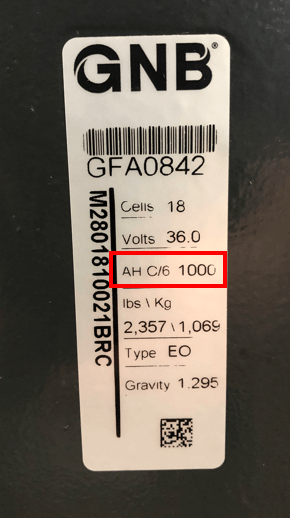
Method 2: Check the Intercell Connector
If the data plate is missing or illegible, you can check the battery’s intercell connector.
This is located near the positive terminal:
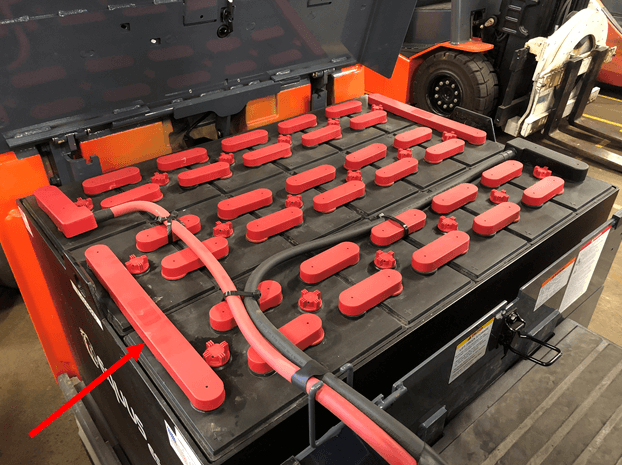
Often, the intercell connector is stamped with the battery's amp hour rating.
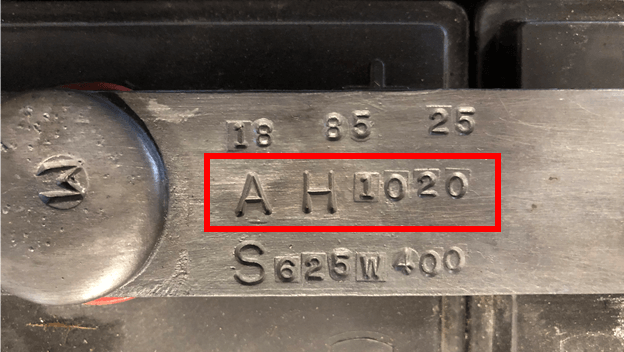
Method 3: Calculate the Amp Hours from the Battery’s Model Number
If you can’t find the amp hours from the data plate or intercell connector, your other option is to calculate it using the battery model number.
Let’s take an 18-85-17 model battery as an example.
Here’s how to calculate the battery’s amp hours:
-
Take the last number (17)
-
Subtract 1 (17 - 1 = 16)
-
Divide that number by 2 (16 ÷ 2 = 8)
-
Multiply the quotient by the middle number (8 x 85 = 680)
-
The product (680) is the battery’s amp hour rating
Once you know your battery’s amp hours, you’ll need to check the charger’s amp hour rating to make sure they’re compatible.
You can find the amp hour rating on the charger’s data tag or in the owner's manual.
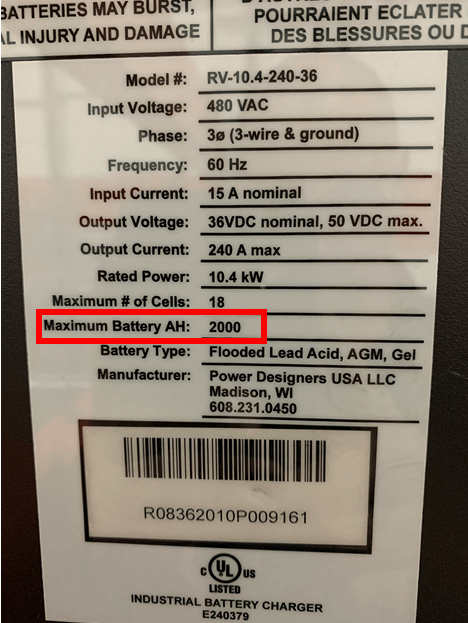
Ensure that it matches the battery’s amp hour rating within +/- 10%.
To do this:
- Multiply the battery’s amp hour rating by 1.1 to find the upper limit
- Next, multiply the battery’s amp hour rating by 0.9 to find the lower limit
Using the example above, 680 x 1.1 = 748 and 680 x 0.9 = 612.
So the charger's amp hour capacity should be between 612 and 748.
Select the Correct Output Voltage
The battery’s voltage must match the charger’s output voltage.
Otherwise, you risk damaging the battery, the charger, or both.
Some chargers are multi-voltage and can accept multiple battery voltages.
But most others are single-volt and only work with batteries of the same voltage.
Here’s how to check the battery voltage:
-
Check the battery’s data plate or intercell connector
-
Look for a three-part model number (like 18-85-17)
-
The first number (such as 18) is the number of cells the battery has
-
Multiply this number by 2 to get the battery’s voltage (18 x 2 = 36 volts)
-
Alternatively, you can count the number of individual cells the battery has
-
If counting, simply repeat step 4 to get the voltage of the battery
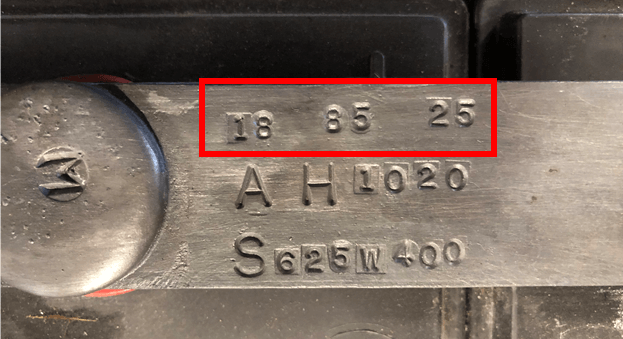
Now, you can proceed and check the charger’s output voltage.
To do so, check its data plate.
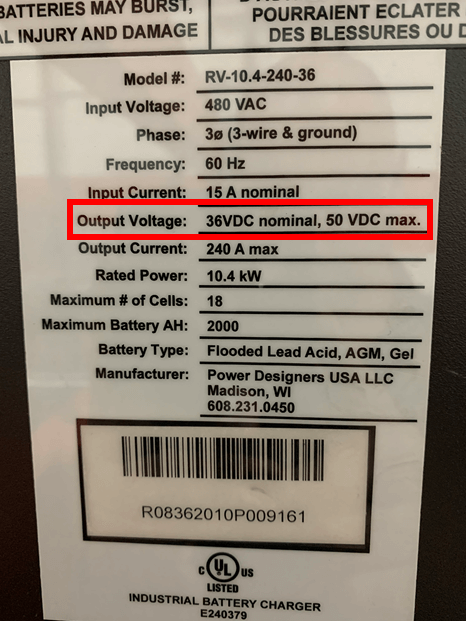
You should see either a single voltage or a range that it can work with.
Select the Correct Input Voltage
The output voltage is the voltage between the charger and the forklift battery.
The input voltage is the voltage between the charger and your facility’s power source.
For example, some voltages include 208 volts, 240 volts, and 480 volts.
And you must choose a charger that accepts the input voltages of your facility.
You can find what input voltage a charger accepts by looking at the data tag.
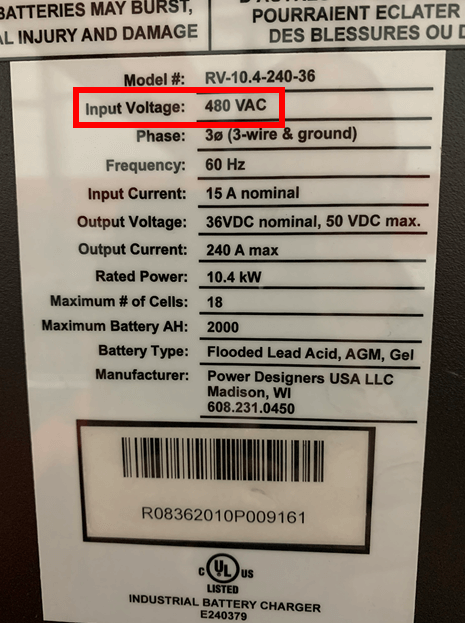
If you’re not sure what voltage your facility is wired for, check with an electrician.
Select the Correct Input Phase
In terms of power load distribution, there are two types of input phases:
- Single-phase power
- Three-phase power
What’s the difference between single- and three-phase power?
Put simply, a single-phase power load refers to a two-wire alternating current (AC) power circuit.
A three-phase power supply, on the other hand, has a three-wire AC power circuit.
Most industrial facilities will have three-phase power lines.
Why?
A three-phase power line delivers power at a steady, constant rate compared to a single-phase power supply.
So you’ll need to ensure your battery charger matches your facility’s phase line.
To determine the phase of the charger you have (or want), you can check its data tag, the owner’s manual, or simply ask the salesperson.
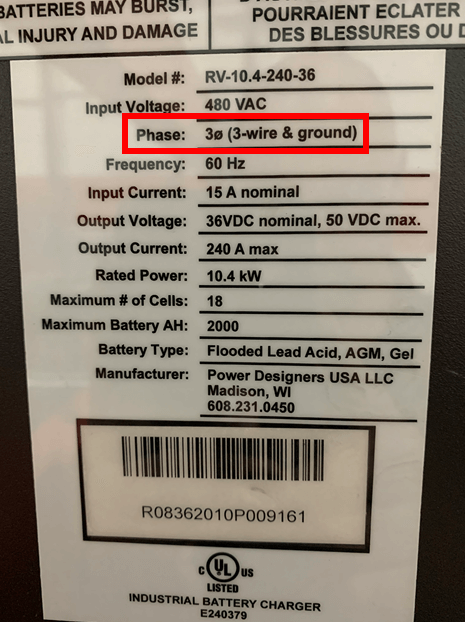
If you’re unsure what phase your facility has, check with an electrician.
Select a Charger With an Equalize Setting
You’ll need to equalize your forklift batteries every now and then.
What does equalizing mean?
It’s a deliberate, forced battery overcharge used to reverse sulfation and stabilize the battery.
By regularly equalizing, you’ll help preserve the integrity and life of your forklift battery.
But you should be aware that not all chargers have an equalize setting.
To determine if your charger does, check the interface or the owner’s manual.
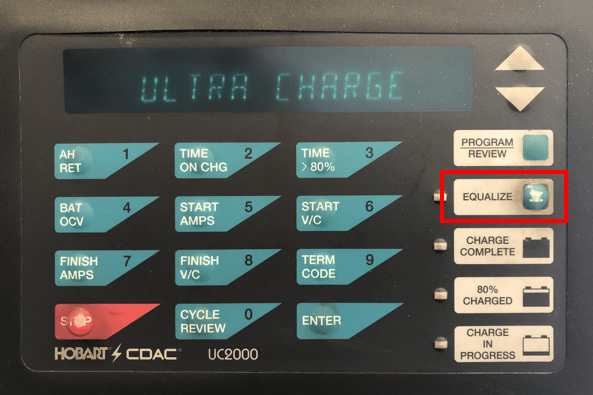
If you’re unsure, ask for help from the salesperson, a technician, or a forklift battery specialist.
Lead-acid forklift batteries can present safety risks during charging.
This is why you need to master the forklift battery charging safety tips and techniques before starting.
Let’s go through some of the major issues that can arise.
What Are the Risks of Charging a Forklift Battery?
Explosive Gasses
You may be wondering: What gases are made when a forklift battery is charging?
The answer: Hydrogen and oxygen.
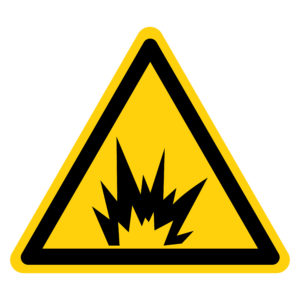
And hydrogen is flammable and highly explosive.
So if it concentrates in the charging room, there’s the risk of an explosion.
Mismatching Charger and Battery Voltage
Using a charger whose voltage doesn’t match (or isn’t compatible with) your battery’s voltage can damage the battery.
This especially occurs if the charger voltage is higher than the battery’s voltage.
Corrosive Chemicals
Battery electrolyte is made of water and sulfuric acid.
And sulfuric acid is extremely corrosive.
If the electrolyte spills and makes contact with the skin, it can cause serious chemical burns.
Electrolyte Boilovers
If the battery is overfilled with water, you can risk boilovers.
This happens when the battery heats up and expands, causing the electrolyte to leak out.
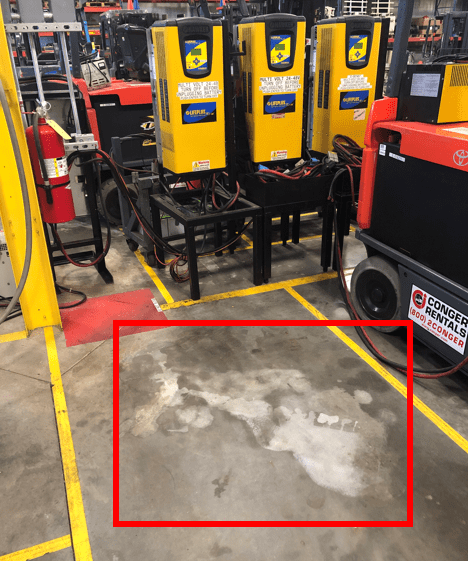
And this can expose you to both corrosive chemicals and burns.
It can also damage the battery, forklift, and surrounding area if ignored.
Electric Shock
Lift truck battery cells store lots of electricity.
So electric shock is always a hazard.
Some folks wonder: Why is it safe to remove jewelry when charging a forklift battery?
The answer is that contact between the battery terminals or cells can complete the electrical circuit.
If your metal jewelry touches those points, you can receive an electric shock and burns.
Excessive Heating
Another thing lots of people wonder is: What causes a forklift battery to be hot when charging?
The answer is that it’s simply the flow of electricity passing through the battery as a normal part of the charging process.
Although some heat is normal, the battery shouldn’t be too hot.
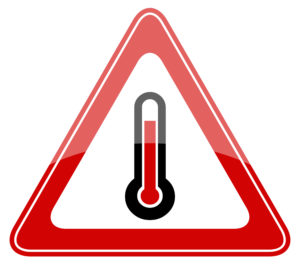
If that’s the case, it indicates that something is wrong.
A battery can be excessively hot for two main reasons:
- The charger isn’t set up properly
- A cell has a short in it
So, what should you do if your battery is getting very hot?
Answer: Shut down the charger and wait until it cools.
Then, check the charger’s setting: Is it putting out more amp hours than the battery can handle?
If so, use a different charger and see if that helps.
Otherwise, if the problem persists, call a qualified forklift battery technician to troubleshoot the issue further.
What Are OSHA’s Forklift Battery Charging Requirements?
Now that you know the risks involved with forklift battery charging, you should also understand that OSHA has certain stipulations to help prevent these risks.
The following is a summary of the battery charging station requirements according to OSHA (Source: 1910.178(g): Changing and charging storage batteries):
1910.178(g)(1): Battery charging installations shall be located in areas designated for that purpose.
1910.178(g)(2): Facilities shall be provided for flushing and neutralizing spilled electrolyte, for fire protection, for protecting charging apparatus from damage by trucks, and for adequate ventilation for dispersal of fumes from gassing batteries.
1910.178(g)(4): A conveyor, overhead hoist, or equivalent material handling equipment shall be provided for handling batteries.
1910.178(g)(5): Reinstalled batteries shall be properly positioned and secured in the truck.
1910.178(g)(6): A carboy tilter or siphon shall be provided for handling electrolyte.
1910.178(g)(7): When charging batteries, acid shall be poured into water; water shall not be poured into acid.
1910.178(g)(8): Trucks shall be properly positioned and brake applied before attempting to change or charge batteries.
1910.178(g)(9): Care shall be taken to assure that vent caps are functioning. The battery (or compartment) cover(s) shall be open to dissipate heat.
1910.178(g)(10): Smoking shall be prohibited in the charging area.
1910.178(g)(11): Precautions shall be taken to prevent open flames, sparks, or electric arcs in battery charging areas.
1910.178(g)(12): Tools and other metallic objects shall be kept away from the top of uncovered batteries.
Additional Forklift Battery Charging Safety Suggestions
In addition to the above, there are other precautions you should take to ensure your employees and facility are safe:
Wear Appropriate Personal Protective Equipment (PPE)
To protect employees from the hazards of forklift batteries, they’ll need to wear personal protective equipment.
The appropriate forklift battery charging station PPE includes:
- Apron
- Goggles
- Face shield
- Rubber gloves
- Safety footwear (gumboots)
You need to protect every part of your body from any possible risk, especially burns.
Install Hydrogen Gas Detectors
The battery rooms should have a functioning detector to monitor the density of hydrogen gas in the charging room.
Ensure your facility’s safety monitor can detect and keep the battery room’s hydrogen accumulation below 25% of the lower explosive limit (LEL).
Post Warning Signage/Labels Identifying Hazards
You should post signage and/or labels to inform and protect personnel and visitors of potential safety hazards.
This can include signs like:
- No smoking
- Appropriate PPE signs
- No metals
- Fire warning guidelines
- Proper battery handling procedures
Maintain Emergency Communications
Keep an active phone in the charging area for communication in case of emergency.
Here’s the step-by-step forklift battery charging procedure:
-
Park the lift truck, set the parking brake, and turn off the ignition
-
Raise the forklift’s hood (for heat dispersion and ventilation purposes)
-
Make sure the charger is turned off before connecting the battery
-
Check that the battery’s voltage matches the charger’s
-
Check that the battery’s amps match the charger’s amps
-
Check for damage to the connectors and cables - fix before charging
-
Disconnect the battery connector from the truck connector
-
Connect the charger connector to the battery connector (NOT the truck connector!)
-
The charger should automatically turn on
-
Wait until the battery is 100% charged
-
Press the “Stop” button on the charger to terminate the charge. Alternatively, the charger may automatically stop when the battery is at 100% charge
-
Disconnect the connectors
-
Plug the battery connector back into the truck connector
-
Once finished and cooled down, check the water levels and add water if the level is down
How Long Does it Take to Charge a Forklift Battery?
It takes about 8 hours to charge a forklift battery to 100%. Plus, you’ll need about 8 hours of cool time (for conventional charging).
Conclusion
That’s it: The complete guide to forklift battery charging.
Now, we’d like to hear from you.
What did you learn about battery charging from this article?
Do you have further questions?
Let us know in the comments section!
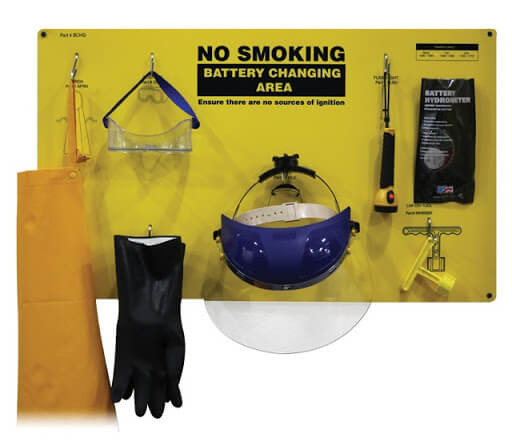
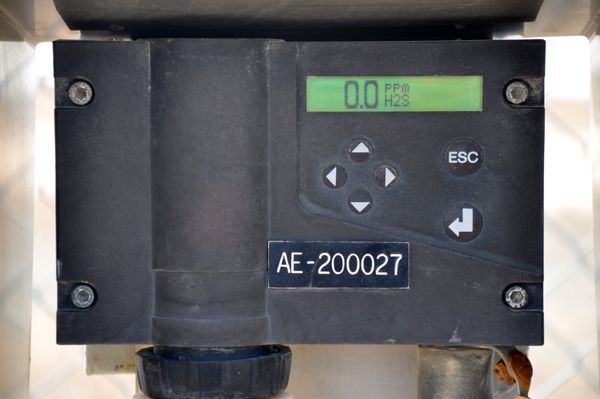
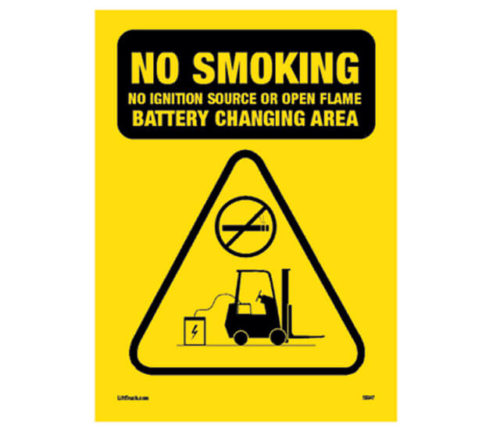
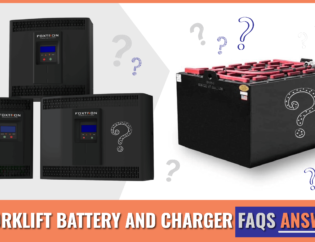
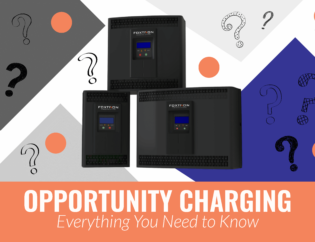

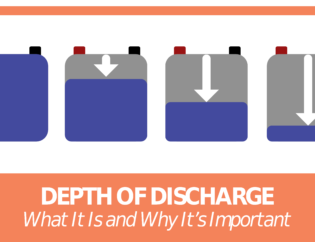
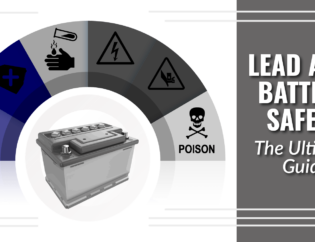


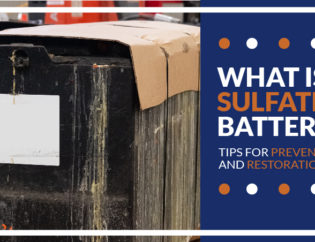
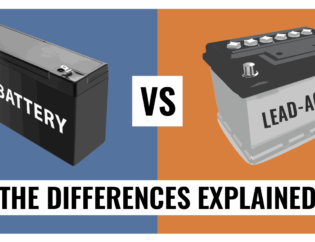

is it normal to hear the water boil when charging a 36v lift truck battery?
Hi Steve,
Yes, boiling is a normal part of the battery charging process. It’s a consequence of electricity passing through the electrolyte/water mixture, and results in the water separating into hydrogen and oxygen. Though boiling is normal, there are a few important things it brings up. First, the hydrogen gas produced can be dangerous if allowed to accumulate. This is why it’s important to have lots of ventilation in battery charging areas. Second, it’s important to make sure the water level in each cell is just above the plate. Otherwise, if the water is too high, it can boil over and spill out of the battery. This is also why it’s critical to only water the battery after charging is complete, so as to reduce the chances of a boil over. I hope that helps and thanks for reaching out!
I have guys that constantly spot charge their lift during lunch break. Regardless of battery level. This couldn’t be good. The charger is set to long charge if I had to guess…not fast charge. I tell them to NOT spot charge but they do anyway. They are killing the battery.
Is this a correct assumption?
Hi Erin,
Yes, that is correct.
If they are lead-acid batteries, they can be thought of as “banks” each with about 1,500 charge cycles. Each time the battery is put on charge, that counts as a single withdrawal from the bank. But it doesn’t matter how much or little the battery is discharged (i.e. 20% or 90%) — it still counts as one withdrawal. So it’s generally better to let the battery discharge to around 20-30% capacity, then put it on charge. This will help strike a balance between not prematurely exhausting the battery’s “bank” account balance while also not allowing the battery to discharge too much (which can cause its own set of problems).
I hope that answers your question and thanks for reaching out!
I’m currently dealing with a batteries that are set-up for opportunity charge and have been for the past 6 yrs, the customer is finally realizing that have spent a ton on batteries every yr for the past 4 years. The fork lifts are from 2002 with clamp attachments. From my understanding clamps tend to draw a lot of amps, is there anything I could suggest as a solution when it comes down to high replacement rate of batteries.
Hi Tim,
Correctly watering the batteries is huge, as well as the acid levels (depending if they’re boiled over a lot). Also, the age of the batteries (if they are from 2002) is an issue. To give you the best answer possible, we’d like to get a few more details about your situation. If you wouldn’t mind dropping us at line through our contact page (https://www.foxtronpowersolutions.com/locations/green-bay-wi/), we’ll get in touch to give you a more detailed answer.
Thanks for reaching out!
Hello!
Are there hazards associated with plugging two forklift chargers into one another by accident?
Hi Steve,
Yes, hazards can potentially be created by plugging two chargers together. This can result in ‘backfeeding’, which is when electricity flows in the opposite direction than expected. Backfeeding can cause explosions, fire, electrocution, and damage to the chargers involved.
While it’s true that many modern forklift chargers have safety mechanisms in place to detect and prevent backfeeding, these systems may not always work. Thus it’s important to always ensure you plug chargers in to the batteries they’re designed to charge and not into other devices they aren’t expecting.
Please your information and explanation, about requirement of charging battery’s location.
Is it safe if the charging location near with electrical panel?
How many meters is the safe distance for the charging location to the electrical panel?
Thank you
Hi Ririen,
You’re correct to point out that you must maintain proper distances from electrical panels — including for battery chargers. For better or worse, only your local building inspector would be able to give you a definitive answer. That said, feel free to drop us a line with your information. We’d be happy to help you navigate your battery charger placement needs. Cheers!